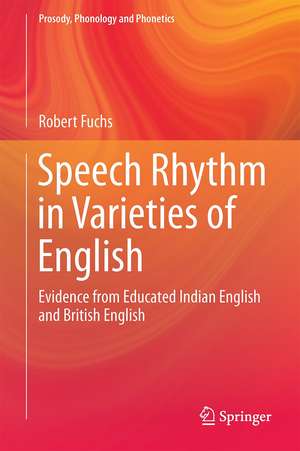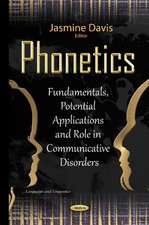Speech Rhythm in Varieties of English: Evidence from Educated Indian English and British English: Prosody, Phonology and Phonetics
Autor Robert Fuchsen Limba Engleză Hardback – 5 oct 2015
| Toate formatele și edițiile | Preț | Express |
|---|---|---|
| Paperback (1) | 385.25 lei 6-8 săpt. | |
| Springer Berlin, Heidelberg – 23 aug 2016 | 385.25 lei 6-8 săpt. | |
| Hardback (1) | 396.24 lei 3-5 săpt. | |
| Springer Berlin, Heidelberg – 5 oct 2015 | 396.24 lei 3-5 săpt. |
Preț: 396.24 lei
Nou
Puncte Express: 594
Preț estimativ în valută:
75.82€ • 79.39$ • 62.89£
75.82€ • 79.39$ • 62.89£
Carte disponibilă
Livrare economică 20 martie-03 aprilie
Preluare comenzi: 021 569.72.76
Specificații
ISBN-13: 9783662478172
ISBN-10: 366247817X
Pagini: 300
Ilustrații: XVII, 226 p.
Dimensiuni: 155 x 235 x 17 mm
Greutate: 0.61 kg
Ediția:1st ed. 2016
Editura: Springer Berlin, Heidelberg
Colecția Springer
Seria Prosody, Phonology and Phonetics
Locul publicării:Berlin, Heidelberg, Germany
ISBN-10: 366247817X
Pagini: 300
Ilustrații: XVII, 226 p.
Dimensiuni: 155 x 235 x 17 mm
Greutate: 0.61 kg
Ediția:1st ed. 2016
Editura: Springer Berlin, Heidelberg
Colecția Springer
Seria Prosody, Phonology and Phonetics
Locul publicării:Berlin, Heidelberg, Germany
Public țintă
ResearchTextul de pe ultima copertă
This book addresses the question whether Educated Indian English is more syllable-timed than British English from two standpoints: production and perception. Many post-colonial varieties of English, which are mostly spoken as a second language in countries such as India, Nigeria and the Philippines, are thought to have a syllable-timed rhythm, whereas first language varieties such as British English are characterized as being stress-timed. While previous studies mostly relied on a single acoustic correlate of speech rhythm, usually duration, the author proposes a multidimensional approach to the production of speech rhythm that takes into account various acoustic correlates. The results reveal that the two varieties differ with regard to a number of dimensions, such as duration, sonority, intensity, loudness, pitch, and glottal stop insertion. The second part of the study addresses the question whether the difference in speech rhythm between Indian and British English is perceptually relevant, based on intelligibility and dialect discrimination experiments. The results reveal that speakers generally find the rhythm of their own variety more intelligible, and that listeners can identify which variety a speaker is using on the basis of differences in speech rhythm.
Caracteristici
Provides evidence on the phonology of the emerging standard IndE Based on a greater number of speakers with a greater number of first languages than previous acoustic studies on the phonology of IndE Studies speech rhythm from two perspectives: production and perception The first publication on speech rhythm based on a multidimensional approach, taking into account variability in duration, intensity, loudness, sonority, voicing, fundamental frequency and the use of pre-vocalic glottal stops (or absence of linking) Develops new methods for measuring speech rhythm that take into account variability in loudness, as well as simultaneous variability in loudness and duration
























